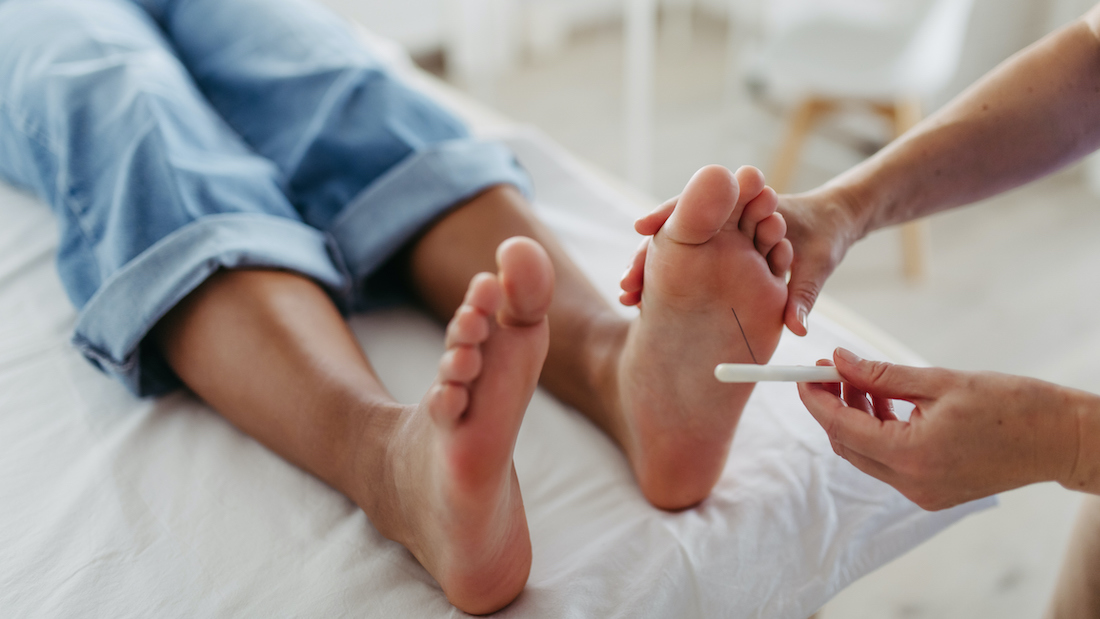Nerve decompression shows promise for diabetic neuropathy patients
Randomized control trial at UTSW suggests long-term benefit in reducing pain in lower extremities

DALLAS – March 20, 2024 – Surgical nerve decompression, used to treat conditions such as carpal tunnel syndrome and sciatica, could play a role in relieving the pain of diabetic neuropathy patients, researchers at UT Southwestern Medical Center found.

The five-year study, published in the Annals of Surgery, was the first randomized control trial to assess the effectiveness of lower extremity nerve decompression surgery on patients with diabetic peripheral neuropathy.
Approximately 20 million Americans suffer from diabetic neuropathy, a progressive condition that damages the nerves, primarily in the legs and feet. The primary treatment today is the use of temporary pain-relieving medications, but many patients find them ineffective after prolonged use.
“Diabetic neuropathy can be debilitating, leading to a lack of mobility and a severe reduction in quality of life,” said study leader Shai Rozen, M.D., Professor and Vice Chair of Plastic Surgery. “It’s believed that roughly one-third of those with neuropathy pain have nerve compression – where there is direct and chronic pressure on a peripheral nerve – due to physiological changes brought on by diabetes. Our research suggests that nerve decompression surgery to release compressed nerves from surrounding tissue could offer lasting relief for those individuals.”
In diabetic neuropathy, nerves can swell and eventually be compressed by surrounding semirigid tissue, causing pain, muscle weakness, or both. In the surgery, the semirigid tissue is removed from the swollen nerve, allowing for improved blood flow to relieve symptoms.
The study followed 78 patients at UT Southwestern and Parkland Health who were randomly placed into two groups – one receiving surgery and one serving as an observation group who remained on medication only. Those selected for surgery also had one leg randomly chosen for “sham surgery” – when the surgeon makes incisions to mimic the procedure but without principal therapeutic actions (i.e., nerve release) – while the other leg underwent nerve decompression.
Patients agreed to being blinded about which leg underwent sham surgery and which had decompression surgery. Additionally, the evaluators were blinded regarding which group the patients were in. “This masking of patients and evaluators further increases the reliability of the results,” Dr. Rozen said.
During follow-up visits, patients completed standard pain and lifestyle questionnaires. At the 12-month visit, the patients who underwent surgical intervention reported significantly less pain in both legs, while the observation group's pain rankings were unchanged.
At 56 months, under the same patient- and evaluator-blinded conditions, the surgical group reported even greater pain reduction, while the observation group had worse pain. Unlike the 12-month follow-up, however, surgical patients reported far more improvement in their decompressed legs than in their sham surgery legs.
“The one-year reports of pain improvement in both legs could mean that there is a placebo effect taking place, but the five-year results suggest that the procedure actually does have a positive long-term impact on pain,” Dr. Rozen said. “There is still much debate in the medical community about the value of decompression surgery in treating diabetic neuropathy, and while this study doesn’t settle the issue, it should help expand the discourse among stakeholders and hopefully lead to even more research. The goal is to better understand the efficacy of nerve decompression surgery on diabetic neuropathy and improve our ability to identify patients who are likely to respond to surgical intervention.”
Other UTSW researchers who contributed to the study are Steven Vernino, M.D., Ph.D., Professor of Neurology; Philip Raskin, M.D., Professor of Internal Medicine in the Division of Endocrinology; Linda Hynan, Ph.D., Adjunct Professor in the Peter O’Donnell Jr. School of Public Health and of Psychiatry; April Gorman, Ph.D., Biostatistician, O’Donnell School of Public Health; and Rita Fulmer, M.S.N., APRN, FNP-C, Physical Medicine & Rehabilitation.
Dr. Vernino is a Distinguished Teaching Professor and holds the Dr. Bob and Jean Smith Foundation Distinguished Chair in Neuromuscular Disease Research and the Rex Griswold Distinguished Professorship in Multiple System Atrophy. He also serves as Vice Chair for Education and Faculty Affairs and is an Investigator in the Peter O’Donnell Jr. Brain Institute. Dr. Raskin holds the Clifton and Betsy Robinson Chair in Biomedical Research.
This study was funded by the National Institutes of Health (UL1TR001105) and the David M. Crowley Foundation.
About UT Southwestern Medical Center
UT Southwestern, one of the nation’s premier academic medical centers, integrates pioneering biomedical research with exceptional clinical care and education. The institution’s faculty members have received six Nobel Prizes and include 25 members of the National Academy of Sciences, 21 members of the National Academy of Medicine, and 13 Howard Hughes Medical Institute Investigators. The full-time faculty of more than 3,100 is responsible for groundbreaking medical advances and is committed to translating science-driven research quickly to new clinical treatments. UT Southwestern physicians provide care in more than 80 specialties to more than 120,000 hospitalized patients, more than 360,000 emergency room cases, and oversee nearly 5 million outpatient visits a year.
About Parkland Health
Parkland Health is one of the largest public hospital systems in the country. Premier services at the state-of-the-art Parkland Memorial Hospital include the Level I Rees-Jones Trauma Center, the only burn center in North Texas verified by the American Burn Association for adult and pediatric patients, and a Level III Neonatal Intensive Care Unit. The system also includes two on-campus outpatient clinics – the Ron J. Anderson, MD Clinic and the Moody Outpatient Center, as well as more than 30 community-based clinics and numerous outreach and education programs. By cultivating its diversity, inclusion, and health equity efforts, Parkland enriches the health and wellness of the communities it serves. For more information, visit parklandhealth.org.
